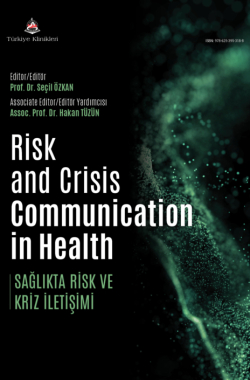Interprofessional Communication in Healthcare Teams
Sultan Pınar ÇETİNTEPEa , Fatma BOZDAĞa
aGazi University Faculty of Medicine, Department of Public Health, Ankara, Türkiye
Çetintepe SP, Bozdağ F. Interprofessional communication in healthcare teams. In: Özkan S, ed. Risk and Crisis Communication in Health. 1st ed. Ankara: Türkiye Klinikleri; 2024. p.48-51.
ABSTRACT
The health sector is a large sector that requires the cooperation of different professionals working together. To ensure co-operation, communication within and between teams should be ensured. Effective and efficient communication increases interprofessional working and positive patient outcomes. Some barriers may occur during communication between professions, which may be caused by the person, technology, or environment. People not knowing or respecting what the other professional’s job is, thinking that there is a hierarchy between professions, gender differences, lack of education, noisy working environment, and not knowing how to use written communication tools can be communication barriers. Inadequate communication between healthcare professionals leads to undesirable results and delayed treatment in patients. To prevent these situations, standardised communication tools have been developed and used in health institutions. Determining communication barriers in institutions and conducting studies on the causes, providing, and updating communication training will ensure that health professionals work in harmony within the team.
Keywords: Communication; interdisciplinary communication; risk management
Kaynak Göster
Referanslar
- Mayo AT, Woolley AW. Teamwork in Health Care: Maximizing Collective Intelligence via Inclusive Collaboration and Open Communication. AMA J Ethics. 2016;18(9):933-40. [Crossref] [PubMed]
- World Health Organization. Classifying health workers: Mapping occupations to the international standard classification. Geneva; 2019.
- Solomon D, Theiss J. What is Personnel Communication. Interpersonal Communication Putting Theory into Practice. 2nd ed. New York: Routledge Taylor and Francis Group; 2022. p.3-20. [Crossref]
- Karam M, Brault I, Van Durme T, Macq J. Comparing interprofessional and interorganizational collaboration in healthcare: A systematic review of the qualitative research. Int J Nurs Stud. 2018;70-83. [Crossref] [PubMed]
- World Health Organization. Framework for Action on Interprofessional Education & Collaborative Practice. Geneva; 2010.
- Conn LG, Lingard L, Reeves S, Miller KL, Russell A, Zwarenstein M. Communication channels in general internal medicine: A description of baseline patterns for improved interprofessional collaboration. Qual Health Res. 2009;19(7):943-53. [Crossref] [PubMed]
- Rosen MA, DiazGranados D, Dietz AS, Benishek LE, Thompson D, Pronovost PJ, et al. Teamwork in healthcare: Key discoveries enabling safer, high-quality care. Am Psychol. 2018;73(4):433-50. [Crossref] [PubMed] [PMC]
- Lindqvist S. Interprofessional communication and its challenges. In: Brown J, Noble SM, Papageorgiou A, Kidd J, eds. Clinical Communication in Medicine. 1st ed. New Jersey, Wiley; 2015. p.157-67. [Crossref]
- Lee CTS, Doran DM. The Role of Interpersonal Relations in Healthcare Team Communication and Patient Safety: A Proposed Model of Interpersonal Process in Teamwork. Can J Nurs Res. 2017;49(2):75-93. [Crossref] [PubMed]
- Keers RN, Williams SD, Cooke J, Ashcroft DM. Causes of medication administration errors in hospitals: A systematic review of quantitative and qualitative evidence. Drug Saf. 2013;36(11):1045-67. [Crossref] [PubMed] [PMC]
- Lee L. Interprofessional communication in emergencies during a pandemic. J Clin Nurs. 2023;32(5-6):e3-5. [Crossref]
- Machaczek K, Whitfield M, Kilner K, Allmark P. Doctors' and Nurses' Perceptions of Barriers to Conducting Handover in Hospitals in the Czech Republic. American Journal of Nursing Research. 2013;1(1):1-9.
- Schwartz F, Lowe M, Sinclair L. Communication in Health Care: Considerations and strategies for successful consumer and team dialogue hypothesis. Medicine. 2010;8(1):e7. [Crossref]
- Etherington N, Wu M, Cheng-Boivin O, Larrigan S, Boet S. Interprofessional communication in the operating room: a narrative review to advance research and practice. Can J Anesth. 2019;66(10):1251-60. [Crossref] [PubMed]
- Müller M, Jürgens J, Redaèlli M, Klingberg K, Hautz WE, Stock S. Impact of the communication and patient hand-off tool SBAR on patient safety: A systematic review. BMJ Open. 2018;8(8):e022202. [Crossref] [PubMed] [PMC]
- Townsend-Gervis M, Cornell P, Vardaman JM. Interdisciplinary Rounds and Structured Communication Reduce Re-Admissions and Improve Some Patient Outcomes. West J Nurs Res. 2014;36(7):917-28. [Crossref] [PubMed]
- Burgess A, van Diggele C, Roberts C, Mellis C. Teaching clinical handover with ISBAR. BMC Medical Education. 2020;20(Suppl 2):459. [Crossref] [PubMed] [PMC]
- T.C. Sağlık Bakanlığı [İnternet]. e-Nabız V.2.1 User Guide 2023. [Access date: 13 March 2024]. Access link: [Internet]. [Link]
- Häyrinen K, Saranto K, Nykänen P. Definition, structure, content, use and impacts of electronic health records: A review of the research literature. Int J Med Inform. 2008;77(5):291-304. [Crossref] [PubMed]

